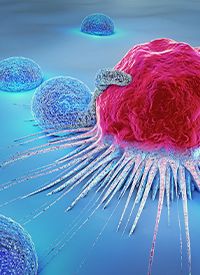OBX-115 Elicits Responses in Advanced or Metastatic Melanoma
The tumor-infiltrating lymphocyte cell therapy OBX-115 produced responses with no dose-limiting toxicities in heavily pretreated patients with advanced or metastatic melanoma whose who had progressed on anti–PD-1 and anti–CTLA-4 therapy with disease that was primary-resistant to immune checkpoint inhibitor therapy.

The tumor-infiltrating lymphocyte (TIL) cell therapy OBX-115 produced responses with no dose-limiting toxicities (DLTs) in heavily pretreated patients with advanced or metastatic melanoma whose who had progressed on anti–PD-1 and anti–CTLA-4 therapy with disease that was primary-resistant to immune checkpoint inhibitor (ICI) therapy, according to topline data from a phase 1 trial (NCT05470283).1
At a median follow-up of 18 weeks, and a data cutoff date of December 1, 2023, OBX-115 induced an objective response rate (ORR) of 50% by investigator assessment and RECIST v1.1 criteria; this included 2 complete responses and 1 partial response. The disease control rate (DCR) was 100%.
Data from the study also support the validation of the cytoDRiVE technology for the regulation of membrane-bound IL-15 to allow controlled proliferation, strengthened persistence and antitumor activity of adoptive T-cell agents.
“The OBX-115 data show its potential to be a meaningful advancement in the treatment of metastatic melanoma and TIL cell therapy,” Parameswaran Hari, MD, MS, chief development officer of Obsidian Therapeutics, stated in a press release. “These initial topline results support the promise for OBX-115 to drive responses in this heavily pretreated patient population and facilitate the expansion of TIL cell therapy in melanoma to a broad group of patients without the need for IL-2.”
The TIL cell therapy is genetically modified to generate membrane-bound interleukin (IL)-15, which could potentially remove the need to co-administer IL-2 as is needed for other investigational unengineered TIL cell therapies.2 Removing the use of IL-2 may result in reduced toxicity. It is hypothesized that membrane-bound IL-15 may improve patient eligibility.
The open-label, phase 1 study enrolled patients with pathologically confirmed, unresectable metastatic melanoma.3 They needed to have stage III or IV disease and at least 1 separate lesion for RECIST v1.1 response assessment, as well as relapsed and/or refractory to ICI treatment with an anti–PD-1 therapy with or without an anti–CTLA-4 agent and/or an anti–LAG-3 agent. They needed to be at least 18 years of age and have an ECOG performance status of 0 or 1.
Within 1 week of tumor harvest, and 1 week of starting lymphodepletion, patients needed to have an absolute neutrophil count of 1000/mm3 or higher, a hemoglobin of 8.0 g/dL or higher, a platelet count of at least 75,000/mm3, alanine aminotransferase/serum glutamic-pyruvic transaminase and serum glutamic-oxaloacetic transaminase of 2.5 x upper limit of normal (ULN) or less, liver function tests of 5.0 x ULN or less, calculated creatinine clearance of 50.0 mL/min or higher, and total bilirubin of 1.5 x ULN or less.
Patients could not have uncontrolled intercurrent medical illnesses or be receiving chronic steroid therapy for primary immunodeficiency. They also could not have received chemotherapy within 14 days before TILs were harvested, nor could they have received a small molecule targeted antineoplastics and chemotherapy in 14 days of the start of lymphodepletion.
The primary outcome measure was to examine the safety and tolerability of the agent. Secondary objectives include ORR by RECIST v1.1 criteria, manufacturing feasibility, duration of response, progression-free survival, and characterization of in vivo cellular kinetics of OBX-115 cells, the pharmacokinetic profile, and immunogenicity.
“These positive results underscore the potential for OBX-115 TIL cell therapy to offer patients with metastatic melanoma a differentiated TIL therapy without the need for IL-2,” Madan Jagasia, MD, MS, chief executive officer of Obsidian Therapeutics, added in the press release.1 “Furthermore, the emerging profile of OBX-115 indicates it will allow expansion of TIL cell therapy into a broad patient population, including those who may not be able to tolerate IL-2 or choose not to receive it. As we look to the future, we are exploring additional indications, including non–small cell lung cancer.”
The safety and efficacy of OBX-115 is also being explored in patients with advanced or metastatic melanoma whose disease is resistant to ICIs as part of a phase 1/2 trial (NCT06060613).4
References
- Obsidian Therapeutics announces positive interim top-line clinical data for OBX-115 engineered TIL cell therapy in advanced or metastatic post-anti-PD1 therapy. News release. Obsidian Therapeutics, Inc. December 12, 2023. Accessed December 13, 2023. https://obsidiantx.com/news-releases/obsidian-therapeutics-announces-positive-interim-top-line-clinical-data-for-obx-115-engineered-til-cell-therapy-in-advanced-or-metastatic-melanoma-post-anti-pd1-therapy/
- Our lead clinical program: OBX-115. Obsidian Therapeutics, Inc. website. Accessed December 13, 2023. https://obsidiantx.com/our-lead-clinical-program/
- Phase I, open-label, study of tumor infiltrating lymphocytes engineered with membrane bound IL15 plus acetazolamide in adult patients with metastatic melanoma. ClinicalTrials.gov. Updated October 16, 2023. Accessed December 13, 2023. https://clinicaltrials.gov/study/NCT05470283
- Safety and efficacy of OBX-115 in advanced/metastatic melanoma resistant to immune checkpoint inhibitors. ClinicalTrials.gov. Updated November 18, 2023. Accessed December 13, 2023. https://classic.clinicaltrials.gov/ct2/show/NCT06060613



